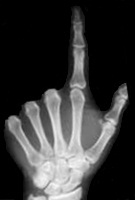Journal Club
May 2010
Failure of metal radial head replacement
- Authors: R. P. van Riet, J. Sanchez-Sotelo, B. F. Morrey
- Institution: Mayo Clinic, Rochester, Minnesota, United States
- Journal: J Bone Joint Surg [Br] 2010;92-B:661-7, VOL. 92-B, No. 5, MAY 2010
- Study type
- Retrospective case series of joint registry database
- Level IV evidence
- Non-funded
- Retrospective case series of joint registry database
Reviewed by
Dr David Shepherd
MBBS | Senior Accredited Orthopaedic Registrar
Introduction
- Background
- Replacement arthroplasty of the head of the radius is commonly used in the treatment of radiocapitellar disorders.
- Acute fracture, and chronic conditions, including nonunion, malunion, post-traumatic osteoarthritis, and when symptoms arise following previous resection of the head
- Most reports of replacements are in the short- or medium-term, and there are very few long-term follow-up studies.
- Failure of replacement leading to revision surgery is mentioned in several studies, but the specific mechanisms of failure and the results of reoperation are currently unknown
- Replacement arthroplasty of the head of the radius is commonly used in the treatment of radiocapitellar disorders.
- Aim
- examine the mechanism of failure requiring revision surgery
- document the findings at the time of re-operation
- examine the mechanism of failure requiring revision surgery
Methodology
- Inclusion
- Revision of radial head replacement at Mayo clinic 1998-2008
- Exclusion
- Patients who had a failed silastic prosthesis
- failure of a radial head component as part of a total elbow or radiocapitellar arthroplasty
- Patients who had a failed silastic prosthesis
- Outcome Parameters
- Timing of initial operation, post-operative complications, mechanisms of failure, and the type of revision surgery.
- The design and fixation used in both the primary and revision procedure.
- Range of movement
- X-Rays
- loosening, instability and radial over-lengthening relative to the lesser sigmoid notch of the ulna.
- joint 'over-stuffing' leading to asymmetry of the ulnohumeral joint.
- Any degenerative changes were graded using the Broberg and Morrey osteoarthritis (OA) scale
- 0 normal elbow
- 1 mild
- 2 moderate
- 3 severe degenerative changes
- loosening, instability and radial over-lengthening relative to the lesser sigmoid notch of the ulna.
- Timing of initial operation, post-operative complications, mechanisms of failure, and the type of revision surgery.
Results
- Results
- 45 elbows (42 patients)
- 42 fractures
- 32% 1/52,
- 17% 6/52,
- 52% >6/52
- 45 elbows (42 patients)
- Initial Radial head replacement
- Initial in 11
- Failure in 34
- ORIF 11, Resection 17, Arthroplasty 6
- Prior revision 7
- Initial in 11
- Design and fixation
- Initial radial head
- Cement 9
- Uncemented 38
- Uncemented polished 13 stems.
- Bipolar design 8
- 4 in prior revisions.
- Cement 9
- Initial radial head
- Reason for Revision
- Clinical reasons for failure of radial head prosthesis
- Pain 40
- Stiffness 18
- Instability 9
- Infection 2
- Pain 40
- Clinical reasons for failure of radial head prosthesis
- Preoperative ROM
- Mean flexion-extension arc 86° (30° to 150°)
- Mean flexion 117° (60° to 150°)
- Mean FFD 30° (0° to 65°)
- 18 patients (20 elbows) functional ROM >100°,
- at least 130° of flexion to < 30° fixed flexion deformity.
- Mean flexion 117° (60° to 150°)
- Pronation-supination arc mean of 110° (0° to 185°),
- Mean pronation of 58° (-15° to 95°)
- Mean supination of 52° (0° to 90°).
- 28 patients (30 elbows) functional arc of rotation
- from at least 50° of pronation and 50° of supination.
- from at least 50° of pronation and 50° of supination.
- Mean pronation of 58° (-15° to 95°)
- No significant difference for flexion, extension, pronation and supination between designs (p > 0.05).
- Mean flexion-extension arc 86° (30° to 150°)
- Overstuffing - ROM
- No significant difference between overstuffed and correct length prosthesis
- flexion, extension, pronation and supination
- (student t-test; flexion p = 0.38, extension p = 0.45, pronation p = 0.79, supination p = 0.65).
- flexion, extension, pronation and supination
- No significant difference between overstuffed and correct length prosthesis
- Radiological findings – Pre-revision
- Implant related
- Loosening 31
- 3 cemented, 11 designed to be loose in canal
- 3 cemented, 11 designed to be loose in canal
- Over-lengthening (over-stuffing) 11
- Radial head subluxation 5
- Radial head dislocation 3
- Component dissociation head from stem 3
- Loosening 31
- Broberg and Morrey osteoarthritis
- Grade 0 - 1
- Grade 1 - 24
- Grade 2- 13
- Grade 3 - 9
- Grade 0 - 1
- Implant related
- Further procedures
- 18 radial head replacements were removed and not replaced.
- 1 Bipolar stem left in situ
- 1 Bipolar stem left in situ
- 24 radial head replacement revised to radial head replacement.
- 18 cemented revision stem
- 17 Bipolar design
- 18 cemented revision stem
- 2 radial head component of a bipolar design was replaced, and the stem was left in situ.
- 1 polyethylene component and a capitellar replacement
- 1 because of dissociation of this component from the stem.
- 3 total elbow replacements
- These three patients (three elbows) are not included in the data in table IV.
- These three patients (three elbows) are not included in the data in table IV.
- 18 radial head replacements were removed and not replaced.
- Severe erosion of the articular cartilage of the capitellum was noted at the time of further operation in 20 elbows.
- Design and the timing of the Index replacement of the radial head.
- There was no significant difference in this interval between the loose-stem unipolar and the fixed-stem unipolar, nor between the fixed-stem unipolar and the fixed stem bipolar designs.
- There were no significant differences between designs for time to failure or osteoarthritis scores (p > 0.05).
- Loosening was less common in fixed-stem bipolar implants.
- Five of eight fixed stem bipolar implants had been cemented in place,
- Three were uncemented.
- Five of eight fixed stem bipolar implants had been cemented in place,
- Radiocapitellar subluxation did not occur in any of the bipolar implants, but capitellar erosion was more prevalent in this group.
- There was no significant difference in this interval between the loose-stem unipolar and the fixed-stem unipolar, nor between the fixed-stem unipolar and the fixed stem bipolar designs.
- Initial timing of index replacement
- More bipolar prostheses were used in reconstructive procedures delayed more than six weeks after trauma.
- Significant increased osteoarthritis score in Delayed implantation(> 6 weeks) compared with Acute implantation < 1 week (p = 0.03).
- Radial head implanted between 1 to 6 weeks compared to acutely
- Significantly increased fixed-flexion deformity (p = 0.03).
- Over-lengthening
- radial head subluxation
- component dissociation
- Instability all occurred more often
- Significantly increased fixed-flexion deformity (p = 0.03).
- Radial head implanted more than six weeks after trauma
- Capitellar erosion more frequent
- More bipolar prostheses were used in reconstructive procedures delayed more than six weeks after trauma.
Discussion
- Conclusions
- Implant loosening
- most common radiological finding prior to further surgery
- 29 patients (31 elbows).
- pain
- In contrast with other authors, all 29 patients (31 elbows) with a radiologically loose implant had pain, which was moderate or severe in 28 patients (29 elbows).
- In contrast with other authors, all 29 patients (31 elbows) with a radiologically loose implant had pain, which was moderate or severe in 28 patients (29 elbows).
- Loosening of a fixed-stem bipolar implant was less common
- Reduced movement
- most common indication for further surgery
- most common indication for further surgery
- Delayed surgery
- more challenging
- Radial head replacement at one and six weeks may be technically more challenging.
- significantly reduced extension compared with the acute group (p = 0.03)
- significantly reduced extension compared with the acute group (p = 0.03)
- Radial head replacement at one and six weeks may be technically more challenging.
- Other technical issues
- such as over-lengthening, radial head subluxation, component instability, all occurred more frequently.
- such as over-lengthening, radial head subluxation, component instability, all occurred more frequently.
- more challenging
- Timing
- most important factor in predicting the prevalence of capitellar erosion
- (55%) who had a radial head replacement inserted more than six weeks after trauma there were clear signs of capitellar erosion.
- most important factor in predicting the prevalence of capitellar erosion
- Failed radial head replacements may lead to:
- re-operation for pain,
- reduced range of movement,
- instability
- infection
- Radiological loosening was prevalent in this group of failed replacements.
- Implant loosening
Pros of Study
- Provides analysis of failed radial head replacements
Cons of Study
- Retrospective
- heterogeneous group
- wide range of indications for radial head replacement
- different designs.
- No indication of overall incidence of failure
Take home message
Loosening is the most common cause of implant failure
Early insertion of radial head replacements in trauma may lead to better outcomes
Webpage Last Modified:
8 September, 2010



